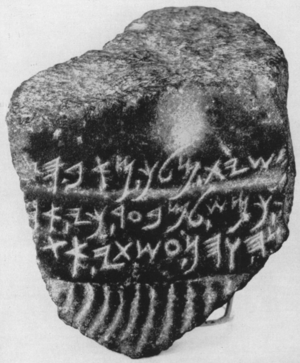نقش الكرك
| نقش الكرك | |
|---|---|
 The inscription | |
| الخامة | بازلت |
| الكتابة | Moabite language |
| أنشئت | c.840 BC |
| أُكتشفت | 1958 |
| الموقع الحالي | Jordan Archaeological Museum |
| الهوية | 6807 |
The Kerak Inscription, also known as the Kemoshyat inscription, was discovered in 1958 in Jordan، بالقرب من وادي الكرك. It is a basalt inscription fragment measuring 12.5 centimeters (4.9 in) high by 14 centimeters (5.5 in) wide. The inscription has been dated to the late ninth century BC. The inscription is known as KAI 306.
The fragment shows a belt, a pleated skirt, and a navel; along the mid-line of the fragment are three lines of نقش كنعاني.
. . . . . . . . . . . . . . . . . . . . . . . . . . . . . . . . . . . . . . . . . . . . . . . . . . . . . . . . . . . . . . . . . . . . . . . . . . . . . . . . . . . . . . . . . . . . . . . . . . . . . . . . . . . . . . . . . . . . . . . . . . . . . . . . . . . . . . . . . . . . . . . . . . . . . . . . . . . . . . . . . . . . . . . .
الاكتشاف
الحجر استحوذ عليه متحف الآثار الأردني في 1958. It was reportedly found by فلاح قدور (أو فلاح البدور)، a bedouin from the Tafilah Governorate. According to Reed and Winnett, Qaddur stated that he had found the stone "in a foundation trench that had been cut for the construction of a new building in Al Karak." A letter from Awni Dajani, then the head of antiquities at the Jordan Archaeological Museum, stated that the stone was found by Odeh Subh el-Khwalideh (a relative of Qaddur) in the house of Suleiman el-Mubayyedin, near the Roman Pool east of Kerak.
النقش
The inscription contains 3 incomplete lines, comprising 8 complete words and fragments of 5 more, all written in the "Moabite language" known from only one other artifact - the Mesha Stele. The text of the inscription looks like that of the Mesha Stele, but there is one special feature: the letter He has four horizontal strokes going to the left from the vertical stroke, while a typical He in tenth to fifth century BC northwest Semitic inscriptions contains only three strokes to the left. This letter is present in the inscription at least 3 times, and each time it appears with 4 horizontal strokes. Another difference between the Mesha Stele and the Moabite inscription, is the separation between the words. In the Mesha Stele there are dots, and in the Moabite inscription there are small lines.
الترجمة اللفظية والمعنى
Provided below is a transcription of the inscription, its transliteration in Hebrew letters, as well as an English translation.[1][2] Words in brackets are not preserved in the inscription, but reconstructed, partly by comparison with the Mesha Stele.
| الخط | Transcription | English translation |
|---|---|---|
| 1 | [I am (name), son of Che]mosh-yat, king of Moab the Dib[onite]... | |
| 2 | [... in the templ]e of Chemosh as a sacrifice, because I lo[ve...] | |
| 3 | [... and beho]ld, I have made it... |
للاستزادة
- A Fragment of an Early Moabite Inscription from Kerak, William L. Reed and Fred V. Winnett, Bulletin of the American Schools of Oriental Research, No. 172 (Dec., 1963), pp. 1–9
- A Moabite-Inscribed Statue Fragment from Kerak: Egyptian Parallels Author(s): Heather Dana Davis Parker and Ashley Fiutko Arico; Source: Bulletin of the American Schools of Oriental Research , No. 373 (May 2015), pp. 105-120; Published by: The American Schools of Oriental Research
الهامش
- ^ "The El-Kerak Inscription" at K. C. Hanson's Collection of West Semitic Documents website
- ^ "Drawing by Christopher A. Rollston and transcription". Archived from the original on 2012-04-26. Retrieved 2011-12-20.